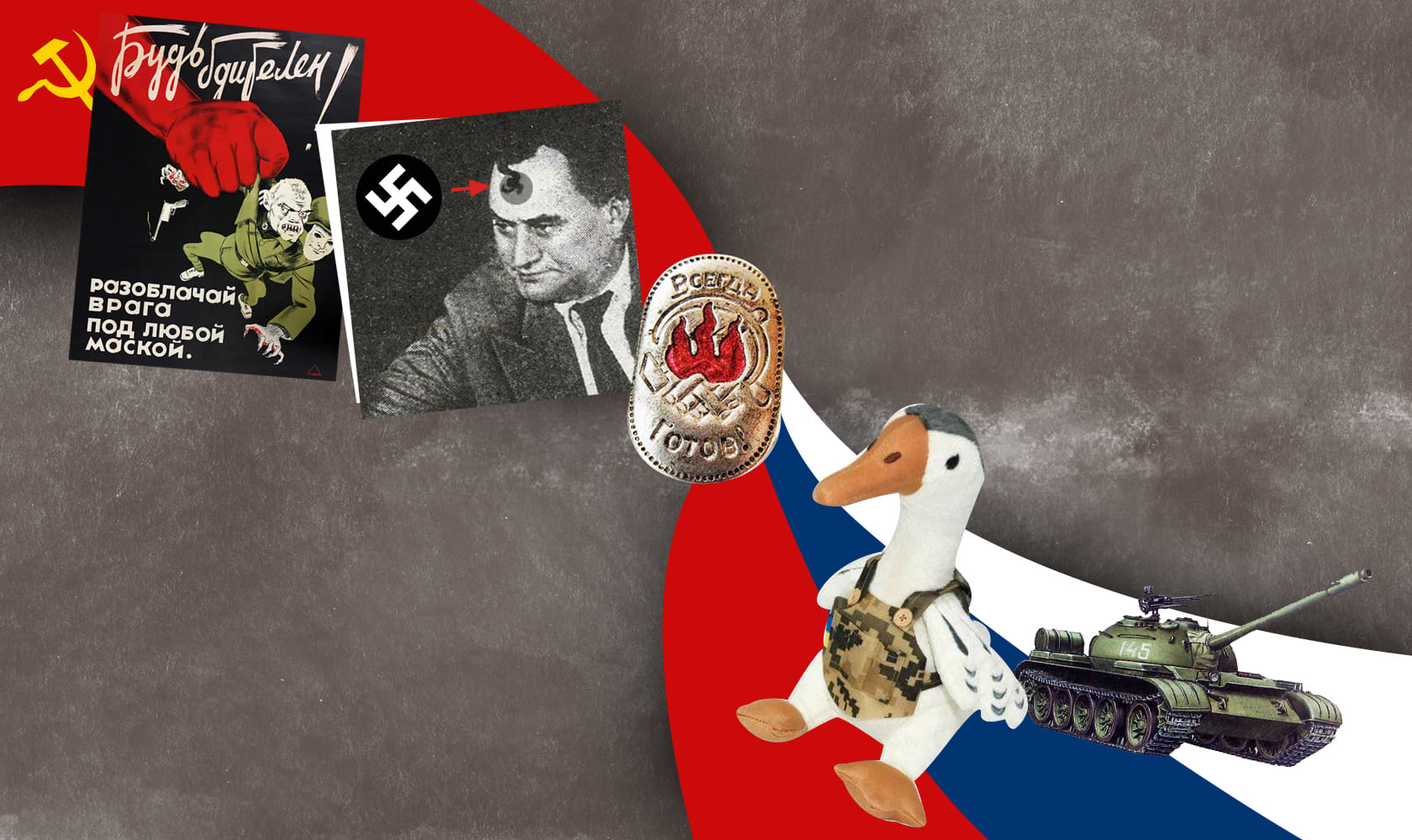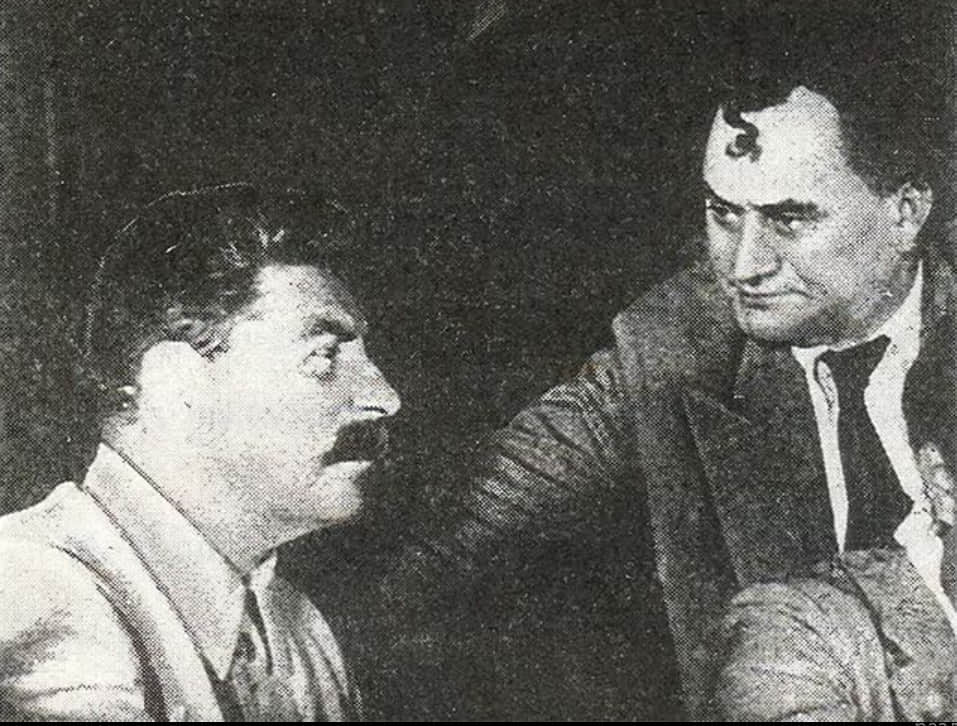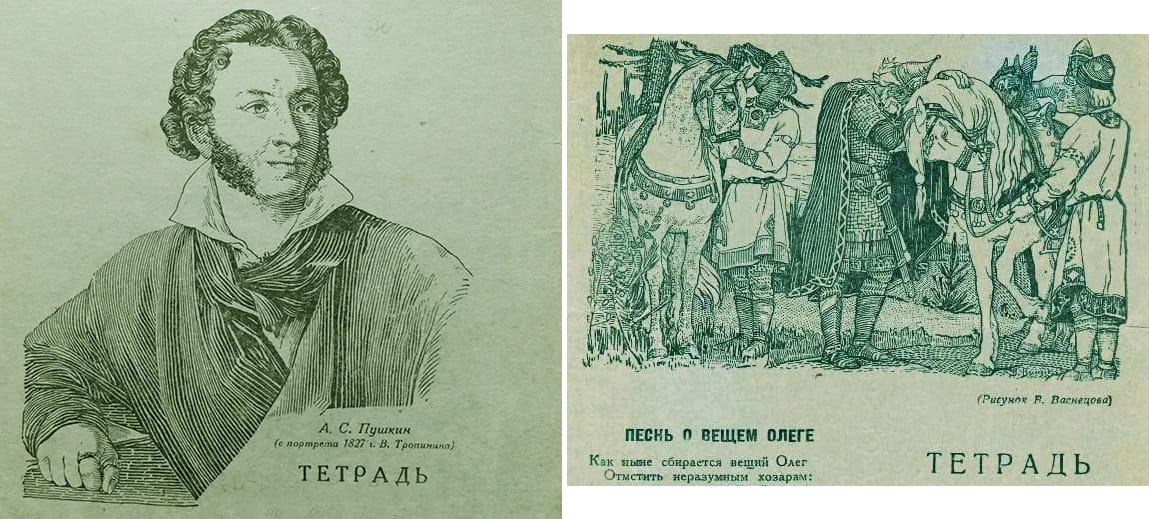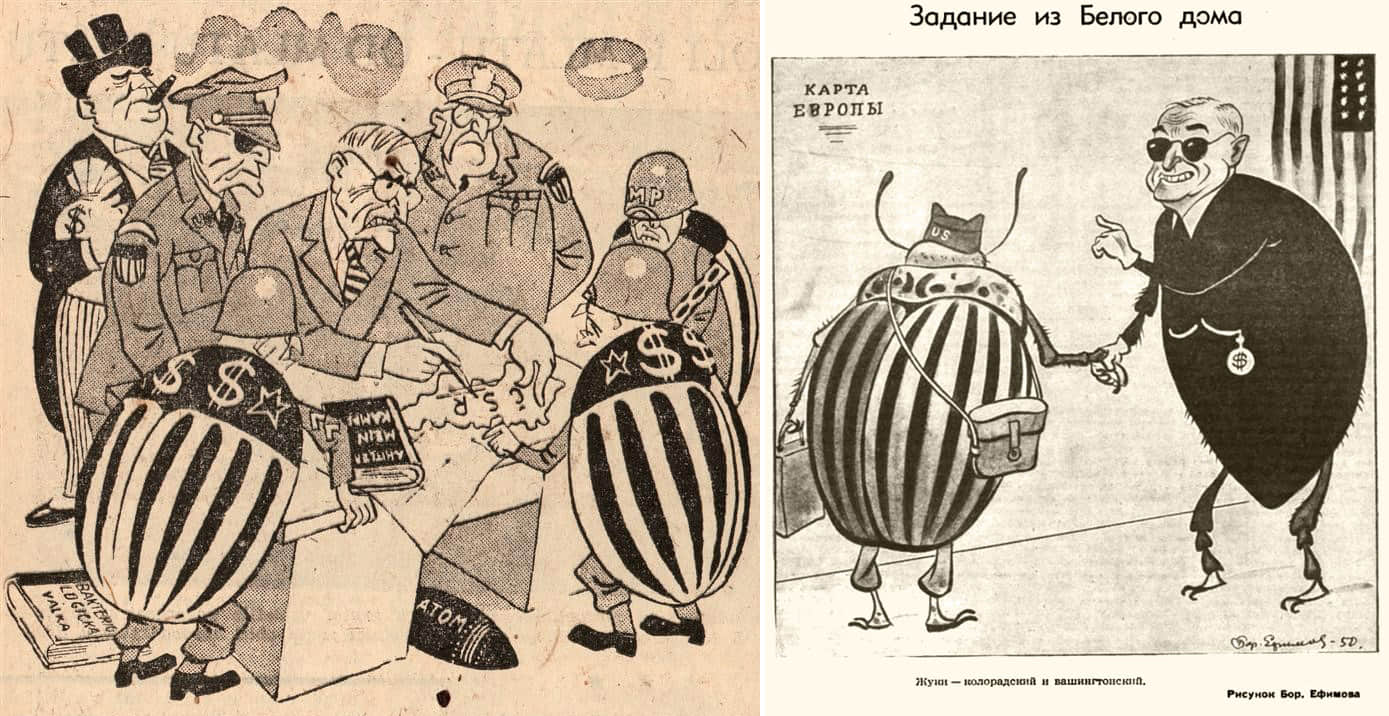Blue and yellow paranoia in Putin's Russia: denunciations and manufactured anxiety about Stepan Bandera, combat locusts, and poisoned money

Ninety years later after Soviet authorities hunted for Nazi swastikas and other symbols in butter churns, on fountains, and on the covers of school exercise books, we are now seeing the Russians hunt for blue and yellow colours.
Instead of Colorado potato beetles [a reference to the allegations in the 1950s that the US deliberately disseminated these pests in the Soviet Union - ed.], there are now Russian claims about combat mosquitoes and locusts [used by Ukraine - ed.] allegedly made by an American manufacturer.
Where once the Soviets spread rumours of poisoned Western chewing gum, now it is banknotes infected with tuberculosis that Russians have claimed are being spread by Ukrainian.
And, of course, there are the ever-present searches for enemies of the people and snitches.
Putin once declared that the collapse of the Soviet Union was "the greatest geopolitical catastrophe of the century", and since then has been doing everything he can to resuscitate the dead man. To that end, an anthropological catastrophe has been added to Russia's "geopolitical catastrophe."
Those who are troubled not only by the Kalibr and Iskander [drones] overhead but also by the question "What is in the minds of murderers, rapists, and looters?" should turn back a few pages of history and remember the Soviet past, which is not very different from the Russian present.
Dangerous signs: a swastika in a butter churn, a saboteur apple tree, and a Bandera tattoo
Olga Z., a resident of Moscow's Yuzhnoye Butovo district, was riding the metro on the orange line when another passenger caught her attention. He was wearing a yellow jacket with a blue sweater peeking out from under it. The fact that a man who looked like Dmytro Yarosh [a Ukrainian nationalist politician and commander - ed.] was sitting next to the suspicious citizen in the carriage also concerned her. She immediately informed the police.
Svetlana Sharkova, a 60-year-old retired woman from the village of Lashino in the suburbs of Moscow, complained to the police that in the midst of the "Special Military Operation" a local gardener was selling apple saplings of the Ukrainian "Glory to the Victors" apple tree variety.
In the city of Pyt-Yakh in the Khanty-Mansi Autonomous District, the headmistress of the local school reported to the police a student who was wearing blue and yellow ribbons in her hair and had a Yin-Yang symbol shaved on her head. According to the headmistress, the symbol can be associated with the "Azov" battalion. The police are investigating.
On the bus going from Dzhankoy to Sevastopol on the Crimean peninsula, which is temporarily occupied by Russia, a pensioner saw a tattoo of Stepan Bandera on the leg of one of the passengers. An alert citizen reported this to the police. As the subsequent investigation showed, the image of "Bandera" on the foot of the "extremist" turned out to be the Irish actor Cillian Murphy in the role of Thomas Shelby, the main character in the gangster series "Peaky Blinders".

In case of doubt, do what you are good at - look for enemies and snitch on people. In August of last year, Roskomnadzor [Russian federal media watchdog - ed.] reported: in the first half of 2022 alone, Russians filed 145,000 reports against other citizens. This is up by 25% over the same period in previous years.
The peak of this epidemic can be said to have been reached by the case of the unemployed 29-year-old Pavlo Protasov in Krasnohorsk who wrote a report denouncing himself! He admitted that, in a drunken state, he had painted a desperate anti-war slogan "no ***" on the wall of his house in yellow and blue colours. Later, when he sobered up, he admitted having made a terrible mistake. Unfortunately, this story leaves unanswered the question of whether citizen Protasov can be considered a "good Russian", or whether he is one only in a state of inebriation.
What is happening today within the territory of the "Russian world" is not some sort of temporary dizziness, but a time-tested national idea of the "Soviet world". The hunt for conspiracies, the search for concealed enemies, and denunciations have been normal ever since the 1930s. However, at that time they were not looking for yellow and blue colours, but for other secret signs.
In December 1935, Glavlit, the main body responsible for censoring all printed publications in the Soviet Union, sent out a directive prohibiting the publication of a photo of the Bulgarian communist Georgi Dimitrov with Stalin. "In the photo, the strands of hair on Comrade Dimitrov's forehead are intertwined in such a way that it resembles a painted swastika," the censors warned.

It was not only living Bulgarian communists that the censors of the day did not spare, but also dead Russian poets. In 1937, the country solemnly celebrated the centenary of Pushkin's death. For the anniversary, a multi-million print run of school exercise books was released with the image of the classic author and the heroes of his works on the covers.
However, on 19 December 1937, schools were ordered to immediately remove the covers of the anniversary exercise books. Thanks to the watchful eye of the then First Secretary of the Kuibyshev Regional Committee of the Communist Party (and previously the Second Secretary of the Central Committee of the Communist Party of Ukraine), Pavel Postyshev, the cover images were discovered to contain secret messages from enemies of the people.
On one of the covers, a swastika was spotted on the poet's ring finger. On another cover, in the left corner of the reproduction of a painting by [the nineteenth-century Russian painter Ivan Nikolaevitch - ed.] Kramskoy, there are corpses wearing Red Army helmets. On Prince Oleg's sword and in the folds of his cloak, Postyshev's eye saw the word "down with", and on his shoes - the letters of the abbreviation "VKP(b)" [Ukrainian Communist Party (Bolshevik) - ed.]. Taken together, this was considered to amount to a criminal slogan.
Millions of harmful covers were removed, and pupils wrapped their exercise books in ideologically approved newspapers, while the "treasonous" artists Petro Malevych and Mykhailo Smorodkin were sent for re-education - in Vorkuta and Kolyma.

Swastikas were spotted in the most unexpected places. For example, in a butter churner manufactured at a Moscow factory. On 15 December 1937, at a meeting of the Bureau of the Central Control Commission under the Central Committee of the Soviet Communist Party, it was determined that the head of the plant, a German national, "installed a second blade in the device, perpendicular to the first. As a result of the location of the blades, the product took on the appearance of a fascist swastika". The case was referred to the NKVD, and tens of thousands of butter churns with these "incorrect" blades were withdrawn from sale.
The search for swastikas did not end even after 1945, moving into the realm of myths and legends. One of these involved eight concrete pigeons on the fountain in the courtyard of the Simferopol railway station, built in 1951. It was said that if viewed from above, they were arranged in the shape of a Nazi symbol, a form of revenge by the German prisoners of war who rebuilt the station after the war. A myth is a myth, but the fountain was "denazified": the two pigeons were removed.
According to another legend, if you look at the clock tower of the same railway station at a certain angle and at a certain time of day, the play of light and shadow allows you to see the Führer's profile.
Anyone looking for a profile of Hitler or the full face of Bandera will always find it - even on the tower of the railway station in Simferopol or on the leg of a passenger on the Dzhankoy - Sevastopol bus.
What do all these cases have in common? This was perhaps best described by the German psychiatrist Klaus Conrad in his book The Beginning of Schizophrenia.
While observing his patients, the soldiers of the Wehrmacht [the German army - ed.], he noted that as their uncertainty and panic intensified due to their inability to control their lives, they began to look for hidden signs of enemies. For instance, one corporal was convinced that his neighbours in the barracks snored at night solely in order to take revenge on him. And it was only by revealing this evil plot that he managed to convince himself that everything was under his control.
When such people make up the majority of the population in a country of millions, whatever it may be, any figure might become a swastika, and each insect might turn into a bacteriological weapon.
Biological weapons: Colorado beetles, killer mosquitoes and other barraging ammunition
Male mallard ducks from the Askania-Nova reserve which carry deadly infections.
Killer mosquitoes carrying yellow fever, plague, anthrax, tularemia and cholera.
Bats that can infect people with pathogens of plague, leptospirosis and brucellosis, as well as coronaviruses and filoviruses.
Combat locusts, prepared specifically to destroy crops in the fields of the Luhansk People’s Republic.
News on clandestine biolabs within the territory of Ukraine roll off the conveyor belt of Russian propaganda in quick succession. Ukraine is portrayed as a training ground for the development of biological weapons on orders from and for money provided byf Americans. At a certain point, these weapons are supposed to surge into the air and with their buzzing and quacking bring the "Russian ethnos" to its knees.
Nobody cared about evidence of "Kyiv’s atrocities" or about whether the accusations had even the slightest plausibility – as you know, the more absurd the lie, the more willingly people believe it. Especially considering the past struggle with an earlier modification of a biological weapon, the Colorado potato beetle, is still alive in the genetic memory. According to propaganda, it was with its help that the Americans tried to starve the Soviet people.
It speaks volumes that even then, "Ukrainian nationalists" were in the spotlight. The first foci of the harmful insect on the territory of the USSR, carried by the wind from Germany and Poland, were discovered in 1949 in Lviv Oblast.
On 28 June 1950, the Soviet Minister of Agriculture, Ivan Benediktov, reported the following to the Secretary of the Central Committee of the Communist Party of the Soviet Union, Mikhail Suslov:
"While creating favourable conditions for the mass reproduction of the Colorado potato beetle, the Americans are at the same time carrying out villainous acts, dropping mass quantities of the beetle from aircraft over a number of areas of the German Democratic Republic and in the Baltic Sea," the minister wrote.

The whole country "knew" that the Americans drop ampoules with beetle larvae from aeroplanes and balloons, send them in special barrels by sea or secretly smuggle them in bottles across the border.
Sabotage with the Colorado potato beetle was compared with dropping the atomic bomb on Hiroshima and Nagasaki. On cartoons in Soviet magazines, campaign brochures and posters, beetles received assignments at the White House directly from US President Harry Truman and were depicted on the American flag instead of the stars.
The battle with the insidious enemy lasted decades. Even in the 1970s, Young Pioneers continued to scour the fields in search of containers, capsules and ampoules with larvae of overseas pests.
Colorado beetles were not alone in the postwar pantheon of enemies of the people. At various times in Soviet and Russian history, they were said to be accompanied by killer mites specially bred in secret American laboratories and scattered by saboteurs along the Baikal-Amur Railway in the late 1970s, by the hogweed which took over up to 40 percent of agricultural land in Russia, planted maliciously by spies, as well as by Georgian mosquitoes, specially infected with Zika virus in the 2010s.
Poisoned gifts: jeans causing impotence, Mao in the coffin and money infected with tuberculosis
What do fairy tales and Russian propaganda have in common? Magical objects that poisoned the heroes of the story: needles, spikes, pins, hair combs, apples.
In July 2022, the Deputy Chair of the State Duma of the Russian Federation, Irina Yarovaya, enriched this fabulous series with new artefacts. In a report on the work of the commission to investigate the activities of American bio-laboratories in Ukraine, she told her colleagues about poisoned banknotes. As early as 2020, she claimed, Ukrainians planted fake banknotes with residents of the Luhansk People’s Republic, infected with "a very dangerous highly pathogenic strain of Asian tuberculosis".
The Russian people readily remembered the fabulous archetypes of old. On social media, there were rumours about explosive devices planted by Ukrainian saboteurs on the streets of Russian cities, disguised as children's toys, wallets and mobile phones. The epidemic of panic turned out to be so menacing that regional authorities had to go so far as to refute the rumours and declare that everything was under control − the enemy would not pass.
However, as in the case of secret swastika signs and killer mosquitoes, modern propagandists merely copy their inventive predecessors from Soviet times.
That said, the range of creepy legends about "poisoned gifts" of the 1970-80s was much richer. There was American chewing gum with razor blades, needles and crushed glass hidden inside. Souvenir fountain pens with explosive devices that foreigners distributed to Soviet Young Pioneers during the 1980 Olympics. And imported jeans with ampoules sewn in the seams containing spirochaetales and bags of lice.
Tight jeans, a symbol of the decadent West, were generally a favourite topic for myth-making. For example, it was argued that wearing them leads to impotence in men and infertility in women, as they interfere with blood circulation and squeeze the sciatic nerve and pelvic bones.
The pinnacle of the Soviet horror stories about "dangerous things" in the late 70s and early 80s can be considered the legend of wall carpets brought from China. On them, with special thread that glows in the dark, the Chinese allegedly applied an image of Mao lying in a coffin that frightened Soviet citizens at night.
There was no definite answer as to why the insidious Chinese needed to do this, other than "because they can". But that did not prevent the spread of this legend, just as for most Russians, the [2014] legend of a Russian boy having been crucified in Donbas does not need evidence.
Of course, stories about poisoned chewing gum and saboteur jeans were not repeated in the editorials of the (Russian) Pravda newspaper. There was no need for that. It is enough to create the grounds and favourable conditions for the existence of ideologically "useful" legends, and they take over reality, like hogweed takes over fields.
***
Finally, a bit of information you can easily live without. Few people know that Sergei Shoigu, Russia’s Minister of Defence and the "Plywood Marshal," as he is called at home, wrote a book under the eloquent title "About Yesterday."
In reality, this is all you need to know not only about the author of the book, but also about the state of his country, stuck in the past tense.
Mykhailo Krygel, Ukrainska Pravda
Translators: Kamila Fomin, Theodore Holmes
Editor: Monica Sandor